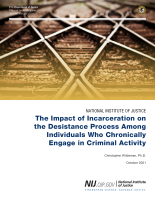Incarceration
Longitudinal Study: Alternatives to Incarceration Sentencing Evaluation, Year 3
The Effects of Parental and Sibling Incarceration: Evidence from Ohio
Reducing Institutional Disorder: Using the Inmate Risk Assessment for Segregation Placement to Triage Treatment Services at the Front End of Prison Sentences
Understanding Incarceration and Re-Entry Experiences of Female Inmates and their Children: The Women’s Prison Inmate Networks Study (WO-PINS)
Desistance From Crime: Implications for Research, Policy, and Practice
Most scholars would agree that desistance from crime – the process of ceasing engagement in criminal activities – is normative. However, there is variability in the literature regarding the definition and measurement of desistance, the signals of desistance, the age at which desistance begins, and the underlying mechanisms that lead to desistance. Even with considerable advances in the theoretical understanding of desistance from crime, there remain critical gaps between research and the application of that research to practice.
See the YouTube Terms of Service and Google Privacy Policy



